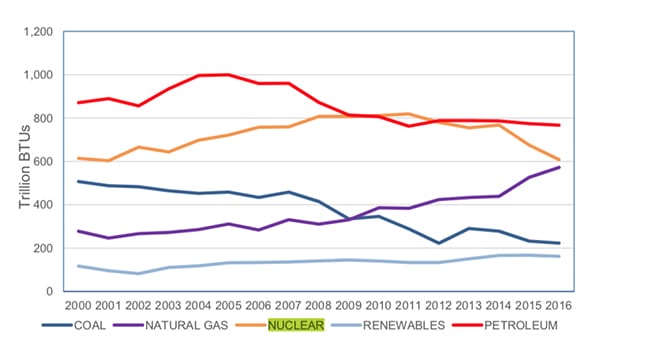Dominion Files to Extend Operations at Surry Nuclear Plant to 80 Years
Dominion Energy has filed an application to extend the operating licenses for two 45-year-old nuclear reactors at the Surry Power Station through 2052 and 2053—when they will be 80 years old.
Surry’s Unit 1 and 2, located near Newport News, Virginia, are three-loop Westinghouse pressurized water reactors (PWRs) that began operation in December 1972 and May 1973. The plant’s initial licenses, which allowed the units to operate for 40 years were extended another 20 years on March 2003. On October 16, Dominion Energy filed an application with the Nuclear Regulatory Commission (NRC) to extend the operating licenses by an additional 20-year term. Unit 1’s current license expires in May 2032, and Unit 2’s in 2033.
Dominion’s Surry nuclear plant is only the third in the nation to file for a subsequent license renewal (SLR) to extend operation from 60 years to 80 years since the NRC in July 2017 issued its final “Subsequent License Renewal Report.” The report is the regulatory body’s staff’s generic evaluation of plant aging management programs and serves as guidance for SLR applicants.
In April 2018, investor-owned Florida Power and Light Co. submitted an SLR application for Turkey Point Units 3 and 4, which are also three-loop Westinghouse PWRs. If approved, the current operating licenses for the 913-MW Unit 3 would be extended to July 2052, and the 923-MW Unit 4, to April 2053. The NRC expects a final decision could come by October 2019.
In July 2018, Exelon Generation and PSEG Nuclear jointly filed an SLR application for Peach Bottom Units 2 and Units 3, which are Mark 1 boiling water reactors in southeastern Pennsylvania. If approved, Unit 2’s license would be extended to 2053, and Unit 3’s, to 2054.
Dominion in November 2017 also notified the NRC that is its readying to submit an SLR application for its North Anna Power Station Units 1 and 2, whose licenses are set to expire in 2038 and 2040. The company will likely file the application before the end of 2020.
On Tuesday, Dominion said it plans to spend as much as $4 billion over the next decade on the relicensing program for Surry and North Anna, which, it noted, “has bipartisan support in Virginia.” Surry’s 1,676-MW is capable of providing 15% of power Dominion’s customers receive, it said.
While the proliferation of gas-fired units and renewables have rattled the economics of nuclear plants across the nation, especially in competitive power markets, the four plants seeking SLRs all appear to have strong capacity factors. Surry 1 operated at 101% in 2017 and 96% in 2016, while Surry 2 operated at 93% in 2017 and 77% in 2016, according to the NRC. Capacity factor is the ratio of the net electricity generated, for the time considered, to the energy that could have been generated at continuous full-power operation during the same period.
Dominion’s application also comes on the heels of the commonwealth’s 2018 Energy Plan. The plan, unveiled on October 4, calls for development of 5 GW of utility-owned and utility-operated wind and solar resources “deemed in the public interest.” That will include 500 MW of rooftop solar (of less than 1 MW in size). It will also require investor-owned utilities to invest $1.1 billion in energy efficiency programs, and establish cost-recovery structures for projects that modernize the grid and support the integration of distributed energy resources.
Dominion owns 100 generation units—a total of 18 GW—throughout the state, including the Surry and North Anna nuclear units,12 coal units, four natural gas (steam) units, 10 combined cycle plants, 41 combustion turbines, 14 hydro, and four biomass units.

On Tuesday, Dan Stoddard, Dominion Energy’s Chief Nuclear Officer noted the Surry renewals would position Virginia for economic growth and help the Commonwealth “remain a leader in the production of clean energy among other states in the mid-Atlantic and South.”
He added: “It supports more than 900 high-paying jobs at the station and produces additional economic and tax benefits.”
—Sonal Patel is a POWER associate editor (@sonalcpatel, @POWERmagazine)